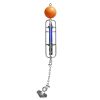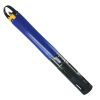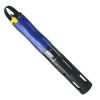NexSens EXO Sonde Mooring Cages
Features
- Integrated mooring clamps sized specifically for EXO sondes
- Hinged pin design allows for quick clamping and release
- Rugged stainless steel frame and PVC clamp construction
- Free ground shipping
- Expedited repair and warranty service
- Lifetime technical support
- More
The NexSens EXO Sonde Mooring Cages provide a secure and convenient means of deploying a YSI EXO multi-parameter water quality sonde. The cage features a 316 stainless steel construction with top and bottom 3/4" eyenuts. The convenient eyenut connection allows the cage to be deployed in-line on an open water buoy mooring or mounted horizontally on a riverbed.
Two integrated PVC mooring clamps are designed specifically for the diameter of a YSI EXO1, EXO2 or EXO3 sonde. Each clamp features a hinged pin design for quick clamping and release. The clamps are positioned at the optimal clamp areas of an EXO sonde so as not to deform the instrument.
An optional mounting crossarm is available for adding photosynthetically active radiation (PAR) sensors. The crossarm allows for both upwelling and downwelling sensors with optional anti-fouling wipers. For saltwater applications, sacrificial zinc shaft anodes are available to attach to the cage and mitigate corrosion during long-term deployments.
- Dimensions: 42" long, 12" diameter
- Weight: 16 lbs.
- Material: 316 SS frame, 316 SS eyenuts, PVC clamps
- Mooring Attachments: (2) 3/4” eyenuts
In The News
Spring 2025 Environmental Monitor Available Now
In the Spring 2025 edition of the Environmental Monitor, we highlight partnerships across the world and the importance of collaboration between government agencies, universities, environmental groups, local communities, and other stakeholders. From great white shark research in Cape Cod to monitoring fisheries in Lake Erie, this latest edition underscores partnerships that connect stakeholders in a watershed through environmental data. With an emphasis on data sharing, a combination of real-time and discrete sampling keeps the public and partners informed of environmental conditions. Our writers also sought out science professionals dedicated to working with peers within and outside of the environmental sector.
Read MoreMonitoring Mariculture in the Gulf of Alaska
The mariculture industry in the Gulf of Alaska has been steadily growing in recent years, guided by ongoing research to help refine farm location and cultivation practices. A subset of aquaculture, mariculture focuses on rearing organisms in the open ocean. In Alaska, finfish farming is illegal, so most farms cultivate kelp, oysters, or a combination of the two. These small, locally operated farms started popping up in the Gulf of Alaska in the early 1990s, when shellfish farming first became legal. Kelp farming did not begin to catch on in the state until 2016. Many of the coastal areas that have grown interested in mariculture are historically commercial fishing communities.
Read MoreSupplying Seattle’s Drinking Water: Using Data Buoys to Monitor the Cedar River Municipal Watershed
Providing clean, safe, and reliable drinking water for the 1.6 million people in the greater Seattle area is a top priority for Seattle Public Utilities (SPU). With limited water supplies, SPU dedicates considerable resources to maintain its watersheds and mountain reservoirs. About 70 percent of Seattle Water comes from the Cedar River Municipal Watershed , and the other 30 percent comes from the South Fork Tolt River Watershed . [caption id="attachment_39574" align="alignnone" width="940"] Data buoy in Chester Morse Lake . (Credit: Kevin Johnson / Seattle Public Utilities) [/caption] Jamie Thompson, a fisheries biologist at SPU, monitors aquatic ecosystems centered on fish listed under the U.S. Endangered Species Act (ESA).
Read More













